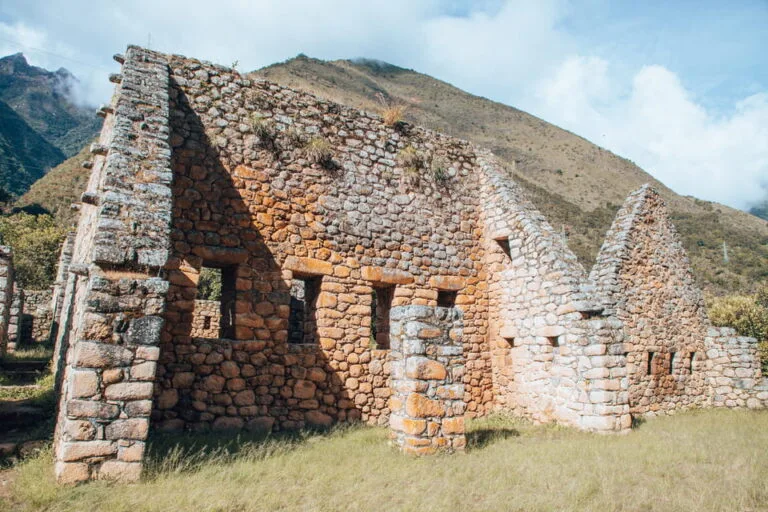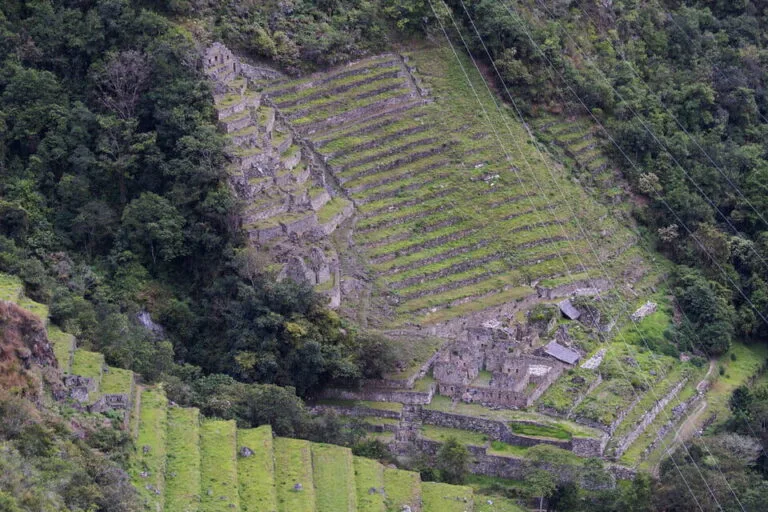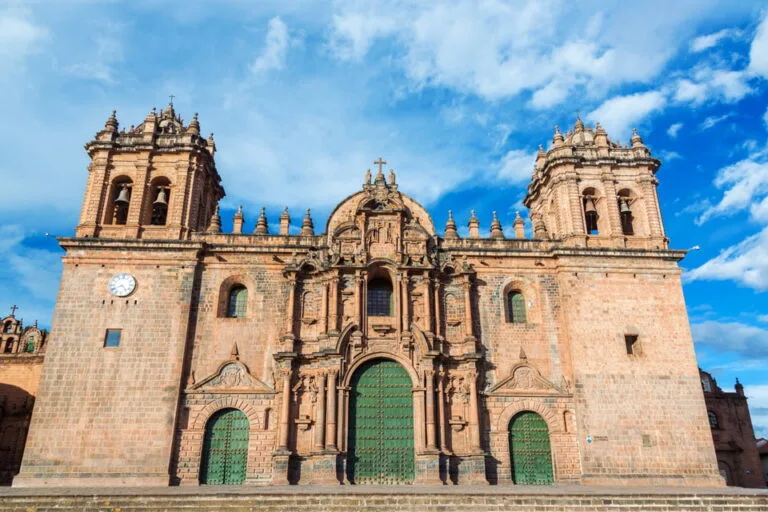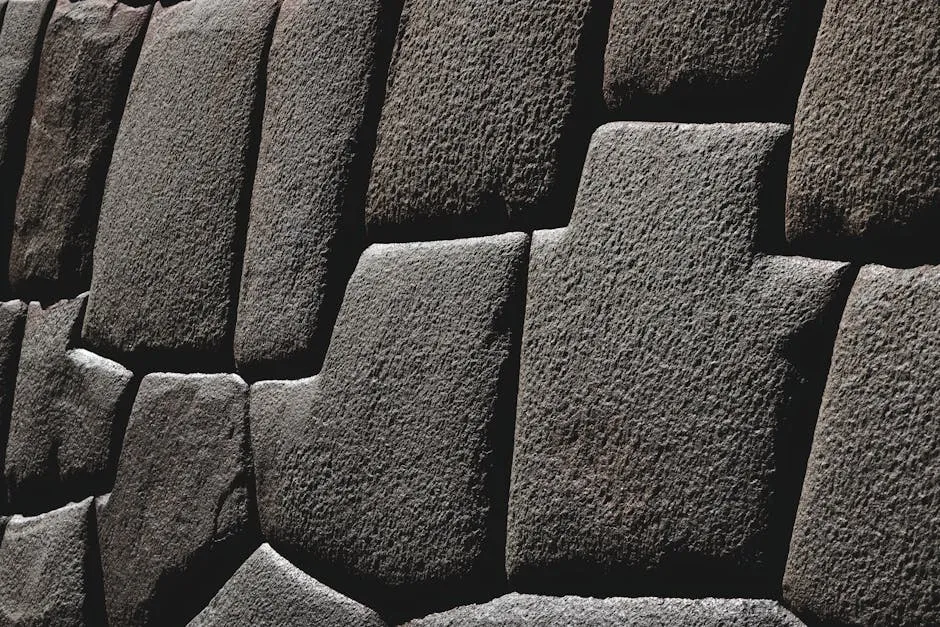Maras is a small town in the Sacred Valley of Peru, internationally recognized for its millenary salt mines and deep-rooted Andean culture. The surroundings of Maras offer a vivid example of how geography, community practices, and history intertwine within the rural Andes.
The Geographic Setting: Maras in Context
Maras is located approximately 40 kilometers northwest of Cusco, at an altitude of about 3,380 meters above sea level. The town stands above the lush Sacred Valley, a region long known for its agricultural fertility and Inca heritage. The landscape around Maras is defined by rolling hills, imposing mountains such as Chikón and Verónica, and sharp drops leading to the Urubamba River basin. This positioning was advantageous for both agriculture and trade during pre-Hispanic times, and it remains strategic today for those traveling between Cusco, Ollantaytambo, and Urubamba.
The climate in Maras is distinctly Andean: dry and sunny from April to October, with cold nights that can dip below freezing, especially in June and July. The rainy season (November to March) brings lushness to the region but also makes some unpaved roads more challenging. This geographical setting shapes not only daily activities but also traditional festivals and farming schedules. While many visitors arrive as part of a day trip from Cusco, it is not uncommon to find travelers who linger longer to explore neighboring communities or trek lesser-known routes connecting ancient sites.
Origins and History of Maras
The foundation of Maras dates back to the late pre-Hispanic period as populations migrated from valleys controlled by the Inca state toward higher terrain. Oral tradition suggests that Maras was established during the time of the waning Inca Empire, possibly as regional populations sought safer ground during Spanish incursions. The Spanish founded new settlements here in the 16th century, leaving behind colonial churches such as San Francisco de Asís—one of the earliest built outside Cusco—whose baroque altar and frescoes remain significant examples of syncretic Andean religious art.
The most distinctive chapter in Maras history is tied to its salt pans, known locally as salineras. These have been used for at least 500 years; however, evidence suggests they predate the Incas, with some local claims tracing their origins back over a millennium. Salt from Maras was once traded throughout highland Peru and even beyond into Amazonian exchange networks. Unlike sites such as Moray—located nearby—where agricultural experimentation prevailed, Maras’ identity has always revolved around salt extraction and trade.
The Salt Pans of Maras: Structure and Operation
The Salineras de Maras consist of more than 3,000 small pools built along a steep hillside. These geometric ponds form a patchwork that stretches across terraces fed by a single subterranean spring rich in saline water. As the water trickles into each shallow pond via an intricate system of channels—some dating back centuries—it evaporates under intense sun exposure, leaving crystalline layers of edible salt behind. Workers then harvest this salt using wooden tools and simple baskets or sacks.
What sets Maras apart from other saltworks worldwide is its method of communal ownership. Each pond is assigned to families from Maras, passed down through generations as both an economic asset and cultural inheritance. Members coordinate maintenance efforts annually in a system reminiscent of traditional Andean ayni, or collective labor exchange. This practice enables equitable distribution of resources while preserving technical knowledge specific to saline management at high altitude.
Modern concerns occasionally arise regarding tourism’s impact on salt quality or water flow; however, local cooperatives have set standards limiting visitor access directly onto working pools. Despite increased regional attention since recognition by programs such as UNESCO’s Intangible Cultural Heritage registry (though the site itself remains unlisted), community stewardship has prevented large-scale industrial exploitation thus far.
Cultural Practices Around Salt Extraction
The cycle of salt production at Maras spans much of the dry season—typically May through October—when evaporation rates are highest. Extraction processes are labor-intensive but highly ritualized; families bless new ponds each season using coca leaves or maize chicha as offerings to Pachamama (Mother Earth), integrating Catholic prayers alongside older Andean traditions.
Certain tasks require collaborative effort: clearing channels after heavy rains or rebuilding pond walls eroded by water overflow. These activities often become occasions for communal meals featuring local foods such as mote (boiled corn), cheese from neighboring dairy farms, or potatoes roasted in traditional earth ovens (wathia). Salt from Maras serves multiple roles: preserving pork or river trout in family kitchens; exchanged for other goods at local markets; or—as is increasingly common—packaged for sale under specialty labels emphasizing its artisanal origin.
This blend of technical knowledge and ritual continuity helps explain why visitors frequently note the intense pride among salineros (salt workers). Local guides frequently recount stories illustrating salt's symbolic value in birth rites or annual festivals like San Isidro Labrador (patron saint of farmers), where blessings are requested for abundant harvests—not only in maize or quinoa fields but also within the white polygons dotting Maras’ hillside.
The Economy of Maras Today: Beyond Salt
While salt production remains integral to household income in Maras, recent decades have seen diversification through tourism and small-scale agriculture. Artisanal salt now reaches international markets via specialty shops in Lima or Cusco, often marketed as “pink Peruvian salt.” Some producers have experimented with flavored salts using local herbs or dried chili pepper (ají amarillo) to meet gourmet demands abroad.
Agriculture continues alongside traditional practices: potatoes, barley, and fava beans are grown on terraced slopes surrounding town limits. In some cases, families rotate between seasonal agricultural work and salt harvesting according to rainfall patterns—a pragmatic adaptation given unpredictable weather associated with climate change.
The arrival of tourism has brought both opportunities and challenges. Income generated by entrance fees at Salineras supports infrastructure maintenance but also increases pressure on roadways not designed for daily motorcoach traffic. In response, local associations have introduced codes regulating vendor stalls near key sites and organized training workshops for guides emphasizing responsible visitor behavior.
Visiting Maras: Practical Considerations and Responsible Tourism
Maras lies on several popular tourist circuits departing from Cusco—commonly paired with nearby sites like Moray (experimental Inca agricultural terraces) or Chinchero (renowned for textile markets). Visitors typically reach Maras via paved road from Urubamba or detour off the main highway linking Cusco with Ollantaytambo; shared minibuses (“colectivos”) operate regularly between key points during daylight hours.
The salt mines themselves charge an entrance fee managed by local cooperatives (updated prices are best checked prior to arrival on official municipal pages). Walking paths allow observation of different stages in the extraction process—from channel feeding through drying mounds ready for shipment—but entry into active pools is restricted for hygiene reasons. Local residents often serve as informal guides offering context on family traditions or technical details overlooked by mass tours.
Simple accommodation exists within Maras itself; however, most travelers base themselves in Urubamba or Cusco due to wider amenities. It is advisable to bring sun protection year-round due to strong UV exposure at high altitude; during rainy months (December–March), waterproof shoes are recommended when exploring unpaved sections near the salt pans.
Community-run kiosks sell artisanal salts packaged onsite alongside textiles or snacks sourced from nearby farmlands. Some visitors opt for walking routes linking Salineras with Moray via scenic footpaths used by villagers—a rewarding way to experience seasonal rhythms often missed by those traveling exclusively by car.
Diversity Within Salt: Types Produced in Maras
The range of salts harvested at Maras often surprises visitors who expect uniformity across thousands of ponds. Distinctions stem from factors like harvest timing (early vs late dry season), depth within each pool at collection, mineral content variation due to microclimate differences—even subtle shifts caused by weather events can influence color and texture.
The most recognizable product is “flor de sal,” a delicate crystalline layer skimming pond surfaces after brief evaporation periods—highly prized by chefs for finishing dishes due to its rapid solubility and mild flavor profile.
Traditional coarse salt forms bulk shipments destined for preservation or general cooking; locally it may appear tinged pinkish-white thanks to trace minerals such as magnesium and iron leached from geological strata underlying the site. Residents sometimes retain special batches for personal consumption during family celebrations or barter exchanges with neighboring communities.
Occasional experiments—with smoked versions using native hardwoods or rock-milled varieties intended for bath salts—reflect adaptation to changing markets without abandoning ancestral extraction techniques passed down through lineages identified with particular terraces since before colonial times.
The Social Structure Behind Salt Ownership
Pools at Salineras de Maras are not state property nor run solely by private companies but rather held collectively under systems resembling traditional Andean land tenure (comunidad campesina). Rights are generally inherited matricentrically; women frequently serve as keepers-of-knowledge regarding which ponds belong where—a counterpoint to stereotypes about male-dominated rural economies.
Family associations coordinate investment needed for larger repairs—infrastructure upgrades after landslides or droughts—while day-to-day decisions remain household affairs.
Patterns observed elsewhere in rural Peru are present here too: migration pressures mean that some younger generations seek work outside agriculture entirely; however, periodic returns during peak harvest ensure continuity between generations who might otherwise lose ties with ancestral land holdings.
Disputes over inheritance occasionally arise but are typically resolved internally rather than through formal legal mechanisms—a reflection both of longstanding custom and contemporary necessity given bureaucratic delays associated with Peruvian land titling processes.
Cultural Nuances: Rituals Associated With Water Sources
The principal source feeding Maras’ pools emerges from inside Qaqawiñay Mountain—a detail that has inspired numerous folk explanations about its origins ranging from petrified tears shed by mythological ancestors to evidence left behind by vanished civilizations predating even Tiwanaku influences.
Annual gratitude ceremonies focus on maintaining harmony between humans and landscape; shamans specializing in Andean cosmology preside over offerings left along spring banks before each season’s first channel clearing.
Blending Catholic saints’ feast days with indigenous commemorations mirrors what anthropologists observe throughout southern Peru—an ongoing negotiation between imported religious frameworks and grassroots spiritual resilience centered around tangible environmental relationships rather than formal dogma.
These rituals reinforce bonds not only between people but between humans and non-human actors—mountains regarded as apus (“protective spirits”), bodies of water imbued with agency reflected linguistically even today when residents speak about “asking permission” before diverting streams into new catchment areas.
Sustainability Challenges Facing Maras Today
Sustaining production at Salineras de Maras, while safeguarding both environmental integrity and intergenerational equity presents ongoing challenges:
- Tourism Pressure: Visitor numbers climbed sharply post-201 following widespread digital media coverage; overcrowding threatens fragile path networks linking terrace levels if unmanaged.
- Water Scarcity: Periodic droughts associated with El Niño cycles reduce spring output; conflicts sometimes emerge over prioritizing domestic drinking water versus industrial-scale extraction schemes proposed periodically (none adopted so far).
- Chemical Contamination: Runoff from upstream farming areas can introduce residues into channels if buffer zones are not carefully maintained—a risk raised repeatedly during cooperative meetings documented by NGOs focused on rural livelihoods.
- Youth Outmigration: As education access widens regionally many teens relocate permanently seeking urban employment—raising questions about future continuity unless new incentives align heritage pride with economic viability long-term.
Lesser-Known Experiences Around Maras
Apart from visiting the salinas themselves—which can be crowded during peak hours—it is possible to engage more deeply with local life:
- Agricultural Workshops: Several families offer practical demonstrations on potato cultivation varieties grown above 3,000 meters altitude—including native tubers rarely commercialized outside Quechua-speaking contexts.
- Ancestral Textile Weaving: Artisans host hands-on sessions showing plant-based dyes sourced locally (such as cochineal red) applied using looms patterned after pre-Columbian motifs still visible in church murals around town square perimeters.
- Trekking Routes: Trails connecting Maras with Moray pass abandoned haciendas converted into research stations studying soil conservation methods adapted for semi-arid slopes—a growing field amid shifting rainfall patterns affecting all highland agriculture today.
- Culinary Tastings: Market stalls occasionally feature salted cheeses aged beneath straw mats using brines taken directly from upper-level pools—a niche product sometimes available only seasonally depending on herd movements among mobile shepherd households (“pastores trashumantes”).
Frequently Asked Questions
- How do I get to Maras from Cusco?
Cusco offers regular transport options: shared vans (“colectivos”) depart hourly toward Urubamba via Chinchero (look for signs mentioning ‘Maras’). From drop-off near highway turnoff it’s roughly 4 km by taxi or mototaxi into town center; organized tours handle all transfers if booked ahead through reputable agencies based in historic downtown Cusco districts like San Blas. - Can I enter the actual salt ponds at Salineras?
No—direct entry into working ponds is prohibited both for hygiene reasons affecting food safety certification abroad and continued channel operation integrity maintained by local family collectives; observation platforms offer close views while ensuring damage does not occur accidentally underfoot during peak harvest months (May–October). - Are there guided tours led by residents?
Yes—many resident families participate informally offering tailored narratives covering legend-rich histories tied specifically either toward their own lineage plots or broader technical innovation adapted since Inca-era hydraulic engineering projects visible along uppermost terraces adjacent main spring outlet sources above communal parking area. - What types of artisanal products should I look out for?
Apart from standard culinary salts available globally now under “Peruvian pink” branding local stalls stock flower-of-salt blends flavored with wild muña leaf infusion plus textile pouches handwoven using sheep’s wool dyed natural cochineal magenta—not commonly exported due limited batch sizes determined entirely according yearly rainfall levels governing final pool output totals each dry season cycle running May through October normally barring El Niño anomalies. - Is it possible to visit both Maras salt mines and Moray terraces in one day?
This combination forms a classic half-day excursion easily arranged either privately (with car hire) or group tour format taking roughly six hours door-to-door including modest time allocated atop panoramic viewing balconies both locations allow comparative insight into contrasting ingenuity characterizing Andean use landscapes across centuries—from saline microeconomies dependent upon spring-fed geology near Maras toward concentric experimental circles marking Moray’s legacy just westward less than 10 km away over ridgelines historically utilized drover trails still visible today after heavy rains clear dust away revealing stonework beneath tufted ichu grasses common above 3,400 meters elevation bounds throughout Sacred Valley basin margins overall.







